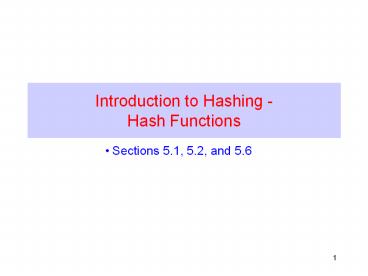Introduction%20to%20Hashing%20-%20Hash%20Functions - PowerPoint PPT Presentation
Title:
Introduction%20to%20Hashing%20-%20Hash%20Functions
Description:
Introduction to Hashing - Hash Functions Sections 5.1, 5.2, and 5.6 * * Hashing Data items stored in an array of some fixed size Hash table Search performed using ... – PowerPoint PPT presentation
Number of Views:122
Avg rating:3.0/5.0
Title: Introduction%20to%20Hashing%20-%20Hash%20Functions
1
Introduction to Hashing - Hash Functions
- Sections 5.1, 5.2, and 5.6
2
Hashing
- Data items stored in an array of some fixed size
- Hash table
- Search performed using some part of the data item
- key
- Used for performing insertions, deletions, and
finds in constant average time - Operations requiring ordering information not
supported efficiently - Such as findMin, findMax
3
Hash Table Example
4
Hash Table Applications
- Comparing search efficiency of different data
structures - Vector, list O(N)
- AVL search tree O(log(N))
- Hash table O(1) expected time
- Compilers to keep track of declared variables
- Symbol tables
- Mapping from name to id
- On-line spelling checkers
5
Hash Functions
- Map keys to integers (which represent table
indices) - Hash(Key) Integer
- Evenly distributed index values
- Even if the input data is not evenly distributed
- What happens if multiple keys mapped to the same
integer (same position)? - Collision management (discussed in detail later)
- Collisions are likely to be reduced if keys are
evenly distributed over the hash table
6
Simple Hash Functions
- Assumptions
- K an unsigned 32-bit integer
- M the number of buckets (the number of entries
in a hash table) - Goal
- If a bit is changed in K, all bits are equally
likely to change for Hash(K) - So that items are evenly distributed in the hash
table
7
A Simple Function
- What if
- Hash(K) K M
- Where M is of any integer value
- What is wrong?
- Values of K may not be evenly distributed
- But Hash(K) needs to be evenly distributed
- Suppose
- M 10,
- K 10, 20, 30, 40
- Then K M 0, 0, 0, 0, 0
8
Another Simple Function
- If
- Hash(K) K P, P prime number
- Suppose
- P 11
- K 10, 20, 30, 40
- K P 10, 9, 8, 7
- More uniform distribution
- So hash tables often have prime number of entries
9
A Simple Hash for Strings
- unsigned int Hash(const string Key)
- unsigned int hash 0
- for (int j 0 j ! Key.size() j)
- hash Keyj
- return hash
- Problem Small sized keys may not use a large
fraction of a large hash table
9
10
Another Simple Hash Function
- unsigned int Hash(const string Key)
- return Key0 27Key1 729Key2
- Problem English does not use random strings
so, the hash values are not uniformly distributed - Using more characters of the key can improve the
hash function
11
A Better Hash Function
- unsigned int Hash(const string Key)
- unsigned int hash 0
- for (int j 0 j ! Key.size() j)
- hash 37hash (Keyj-a1)
- return hashTableSize
- The for loop computes ?ai37n-i using Horners
rule, where ai has the value 1 for a, 2 for
b, etc - a3 37a2 372a1 373a0 37(37(37a0 a1) a2)
a3 - The for implicitly performs arithmetic modulo 2k,
where k is the number of bits in an unisigned int
12
STL Hash Tables
- STL extensions
- hash_set
- hash_map
- The key type, hash function, and equality
operator may need to be provided - Available in new standard as unordered set and
map - lttr1/unordered_mapgt or ltunordered_mapgt
- lttrl/unordered_setgt or ltunordered_setgt
- Example Lec24/hashmapex.cpp
- Reference
- www.open-std.org/jtc1/sc22/wg21/docs/papers/2003/
n1456.html































